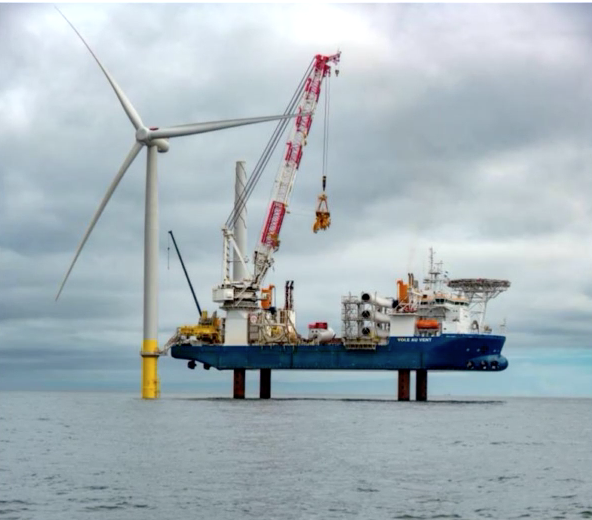The fledgling U.S. offshore wind industry is gathering critical mass in southern New England, where a forthcoming environmental assessment of the 800-megawatt Vineyard Wind plan could determine how it and a dozen other East Coast projects might proceed.
Expo Online: Offshore Wind — The Pros Weigh In
Fishermen in the Northeast fleets, heirs to a 400-year New England industry, are deeply engaged on scientific, political and legal fronts, trying to slow what they see as federal and state governments overenthusiastic about granting wind developers chunks of the outer continental shelf.
In June 2018, East Coast fishing industry leaders organized the Responsible Offshore Development Alliance to represent fishermen’s interests to the wind industry and government regulators. Annie Hawkins, RODA’s executive director, says fishermen on every coast need to get involved.
“Just because the current projects are not located in your area doesn’t mean they won’t affect you,” Hawkins wrote in a July 2 commentary in NF. “A relatively small group of developers own the leases, and the federal permitting process is being tested and tweaked in real time.
“Even states are following closely in the footsteps of others, as was recently seen when Massachusetts largely followed a Rhode Island-developed process for compensatory mitigation for the Vineyard Wind project. The developer stated its intent for that process to set precedent for every project in every state,” says Hawkins.
In early 2020, West Coast fishermen joined with RODA to set up a Pacific advisory council. It has attracted membership from every fishery in the region, with fishermen recognizing how the political climate in California, Seattle and Washington favors developing renewable energy sources. Alongside decades-long policies to preserve its coast and ocean environment, California has more recently committed to seeking 100 percent renewable power sources.
“We realize that we’re anywhere between a year and three years behind what’s going on on the East Coast,” said Mike Conroy, executive director of Pacific Coast Federation of Fishermen’s Associations and an early member of the RODA Pacific committee. “In terms of raising awareness, it’s been invaluable.”
Like East Coast fishermen, Conroy said the Pacific fishing community were surprised by the surging interest in developing offshore wind energy. But in the last few months, the RODA committee has been able to establish contact with federal and state regulators. The group has been invited by the federal Bureau of Offshore Energy Management and California state officials to discuss the central coast area being considered for leases, he said.
In summer 2019 the BOEM was poised to issue a positive environmental impact statement on the Vineyard Wind project until NMFS’ Greater Atlantic office balked.
Motivated by fishermen’s alarm and their own scientists’ concern that more studies were needed, NMFS refused to sign off on the environmental report.
That led to Secretary of the Interior David Bernhardt ordering a fuller re-examination of Vineyard Wind, and of the potential “cumulative impacts” of building turbine arrays from Massachusetts to the Carolinas.
“I think the Vineyard Wind EIS opened up some eyes out here,” said Conroy.
A final report is due Dec. 18. But in the meantime, presidential election politics have thrown more doubts into the picture.
With Southeast states now seemingly in play, President Trump has been shoring up support there with a 180-degree turnaround from his 2018 goal of opening all U.S. offshore waters to energy development.
Starting at a Sept. 8 campaign stop in Jupiter, Fla., Trump announced a 10-year moratorium on energy leasing in federal waters off Florida, Georgia and South Carolina — and on Sept. 25 extended that to North Carolina, and hinted Virginia waters may be next.
The offshore energy industry based in the Gulf of Mexico protested.
“An offshore moratorium that stretches from the Eastern Gulf of Mexico to the top of North Carolina’s offshore areas needlessly jeopardizes our nation’s long-term economic and national security,” said Erik Milito, president of the National Offshore Industries Association. “The announcement also casts tremendous uncertainty on the outlook for wind offshore off North Carolina.”
Existing offshore wind leases are not affected, and the Trump orders leave open the possibility of new offerings in the Northeast.
The pre-election maneuvers left skeptics on all sides. Frank Knapp Jr. of the South Carolina Small Business Chamber of Commerce, a group allied with environmental activists and other offshore drilling opponents, foresaw a post-election double-cross.
“But if Trump wins re-election in November, his motivation for issuing the moratorium — which is to make an election-year appeal to voters — will no longer exist,” Knapp wrote in the Myrtle Beach Sun News. “There will be nothing to stop the president from reversing his Executive Order and instructing his agencies to move forward with his long-term goal, which is to open up the Atlantic for oil drilling.”
Meanwhile, BOEM and other agencies in the Trump administration forge ahead with planning for offshore wind developments. In early October the federal Economic Development Administration released a $2.16 million grant to Maine to develop wind power in the Gulf of Maine.
“If you believe the BOEM folks, we’re looking out at least five years” before a West Coast pilot project,” said Conroy. That’s why RODA’s organizing the industry now has been so vital, he said.
The clock is ticking. In October the U.S. Department of Energy, working with BOEM, deployed two research buoys off California for the first time, to gather weather and oceanographic data for planning offshore wind energy areas.
The Expo Online panel discussion on Tuesday, Nov. 17, will review where offshore wind development stands from coast to coast and what the next steps are for advocates across the spectrum of U.S. maritime industries. You can find that discussion at NationalFisherman.com/expo-online.







